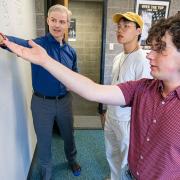Editor’s Note: This is part of a series called UChicago Class Visits, spotlighting transformative classroom experiences and unique learning opportunities offered at UChicago.
When mixing disciplines, there are some subjects that are much more readily paired—psychology and biology or visual arts and photography. However, one physical science course at the University of Chicago seeks to combine three subjects that aren’t a natural fit on the surface. “The Chemistry of Artists' Materials,” taught by Assistant Instructional Professor Hannah Lant, blends together art, history and science.
When Lant started her position at UChicago, she was asked to develop a chemistry course as part of the University’s College Core Curriculum. Lant thought back to her background in alternative energy and considered creating a class focused on climate change. However, she quickly realized that the subject was already covered in several courses, so she shifted focus towards an unexpected discipline—the humanities.
“Pigments and dyes always fascinated me,” Lant explained. “I hadn’t spent much time diving into it besides my own dabbling in artistic pursuits.”
Drawing from her current artistic practice in stained glass, analog photography, and working with natural dyes, Lant figured a class on the science of art materials would be the perfect opportunity to dive into the overlap between chemistry and art. This heavily interdisciplinary lens resulted in a course that became a “perfect example of liberal arts in action.”
Art in the Lab
The course meets three times a week for a lecture and once a week for a lab. In the classroom, students learn about the fundamentals of chemistry and its technical aspects. Once they get into the lab, students get to put what they learned throughout the week into practice.
Before each lab session, students are assigned historical literature explaining how artists’ materials were produced in the past. For example, a reading assignment from week three explained how people used to process flowers to extract safflower dye, a chemical process historically performed by cultures across the Eurasian continent as a source of reds, pinks and yellows. These lessons provided a foundation for what was to come when students entered the lab for their hands-on experience.
During week six, the lab session included a visit to the Joe and Rika Mansueto Library’s Preservation Laboratory. This trip exemplified another important aspect of art: how to protect and preserve a piece over time. In conservation science, experts learn not only how to conserve pieces, but also how to identify what was used to make them in order to timestamp and authenticate them.
In this lab, students looked at an early Meiji-era (1868-1912) Japanese print borrowed from the library’s Visual Resources Center and housed in the Department of Art History. The class used the laboratory’s equipment to investigate the print’s chemical makeup with the goal of finding its earliest possible date of production, also known as the terminus post quem (The answer was 1878).
Lant’s teaching assistant, Katelyn Feuling, describes this course as “one of the coolest classes” as it helps students learn about everyday items that aren’t often thought about scientifically. Student Alina Qiu reiterated Feuling’s thoughts, calling the class “super interesting,” especially since dyes and pigments are so closely applicable to the real world.
By the end of the quarter, students in the class will have acquired skills that span several different subjects, some of which they’ll use in future coursework. And like many UChicago Core courses, “The Chemistry of Artists’ Materials” is proof that the line between the sciences and humanities is pencil thin.
—Adapted from an article that originally appeared on the UChicago College website.

